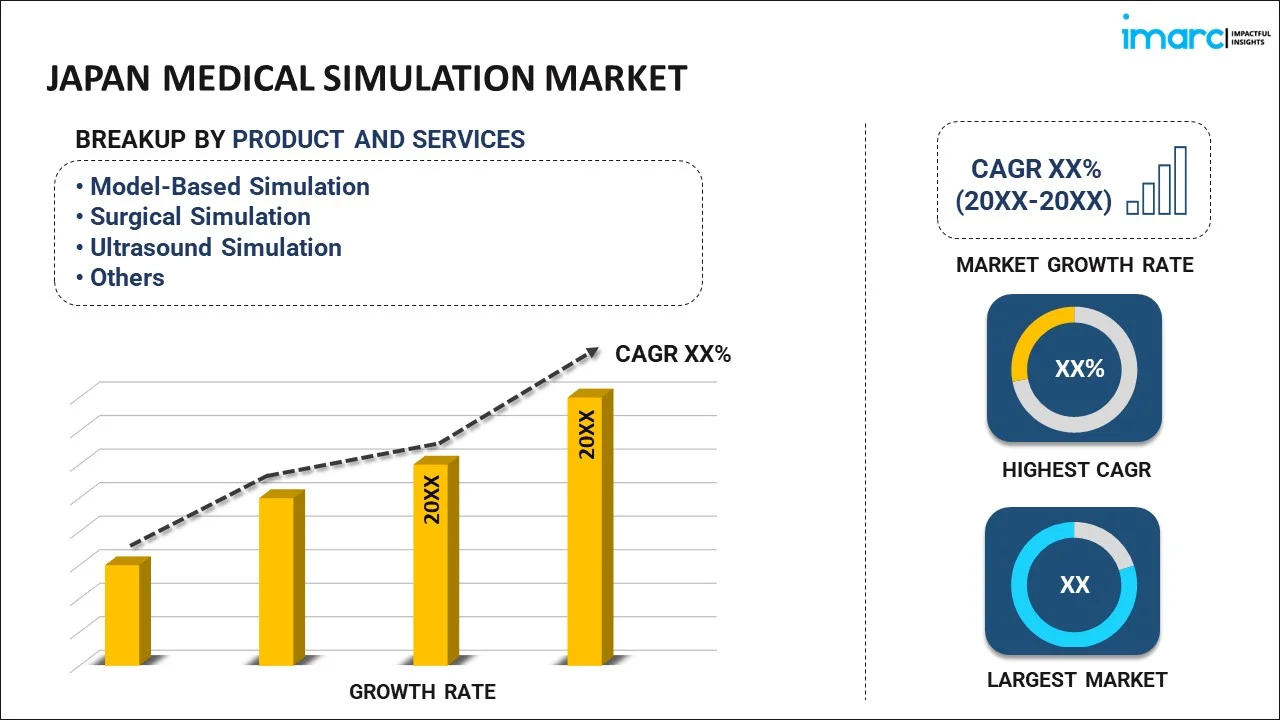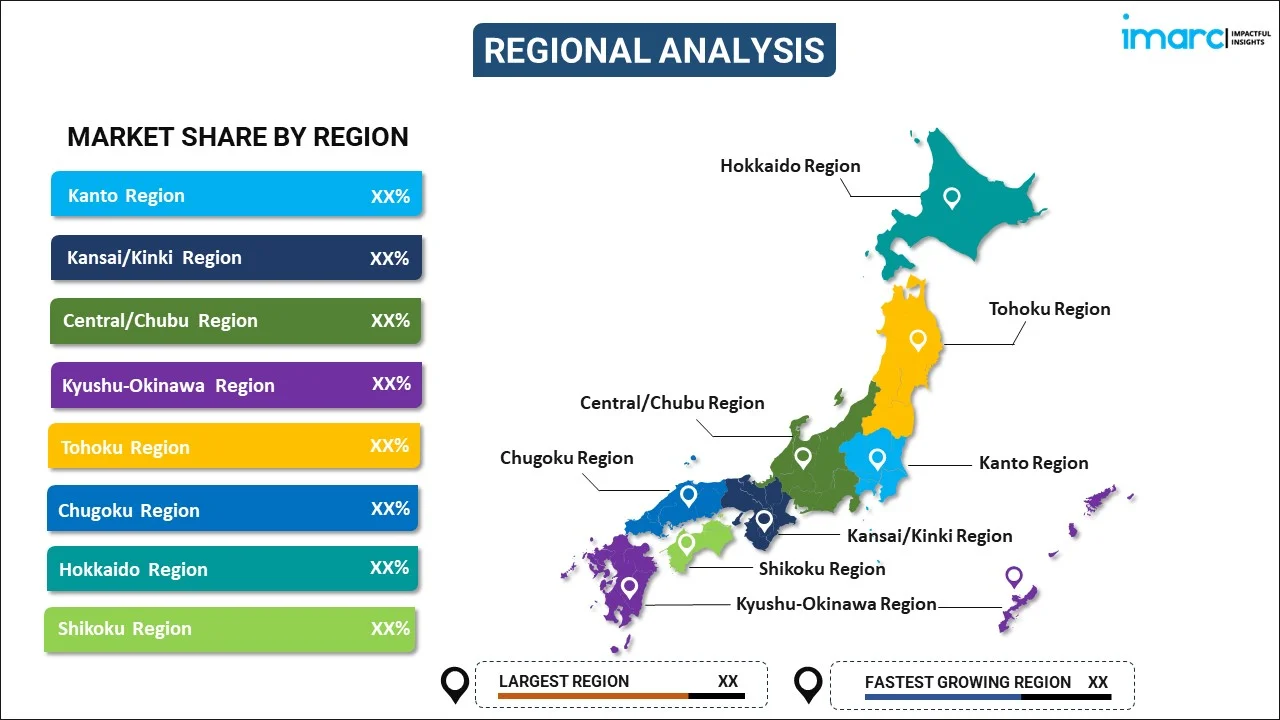
Japan Medical Simulation Market Report by Product and Services (Model-Based Simulation, Surgical Simulation, Ultrasound Simulation, Web-Based Simulation, Simulation Training Services), Fidelity (Low Fidelity, Medium Fidelity, High Fidelity), End User (Hospitals and Clinics, Academic Institutions and Research Centers, Military Organizations, and Others), and Region 2025-2033
Market Overview:
Japan medical simulation market size reached USD 131.6 Million in 2024. Looking forward, IMARC Group expects the market to reach USD 528.3 Million by 2033, exhibiting a growth rate (CAGR) of 15.4% during 2025-2033. Various technological advancements in the healthcare sector, coupled with the increasing popularity of medical visualization, are primarily driving the market growth.
|
Report Attribute
|
Key Statistics
|
|---|---|
|
Base Year
|
2024 |
|
Forecast Years
|
2025-2033
|
|
Historical Years
|
2019-2024
|
| Market Size in 2024 | USD 131.6 Million |
| Market Forecast in 2033 | USD 528.3 Million |
| Market Growth Rate (2025-2033) | 15.4% |
Medical simulation involves the digital replication of real-life medical scenarios for the purposes of training, receiving feedback, and gaining experiential learning. It is a widely used educational tool among healthcare professionals in training, including doctors, nurses, surgeons, and others, enabling them to acquire, practice, and evaluate their skills within a safe and controlled environment. Medical simulation encompasses a range of resources, including anatomical models, procedural trainers, and virtual reality (VR)-based systems, catering to various medical disciplines such as laparoscopic surgery, gynecology, cardiology, arthroscopy, spinal procedures, endovascular interventions, dentistry, and ophthalmology. It facilitates feedback from different sources, including instructors, peers, simulated patients, and video recordings. This feedback mechanism contributes to improving patient safety, enhancing communication skills, and refining crisis resource management. Due to its significant benefits, medical simulation is widely applied in diverse settings, including hospitals, educational institutions, military establishments, research centers, and outpatient care facilities.
Japan Medical Simulation Market Trends:
The Japan market is experiencing a positive outlook, driven by several key factors. Firstly, significant growth in the medical industry is playing a crucial role in shaping the market's prospects. Furthermore, there is an increasing awareness among the general population about the advantages of simulation-based learning, which is contributing to the growth of the market. In addition to this, the widespread adoption of laparoscopic simulation systems, particularly for effective cancer treatment, is a notable driver of market growth in Japan. Moreover, various technological advancements, such as the incorporation of augmented reality (AR), robotics, and artificial intelligence (AI) solutions into interventional simulators, are acting as additional catalysts for growth. These simulators find extensive use in training physicians in performing procedures like cholecystectomy, appendectomy, gastric bypass, tubal ligation, and hysterectomy. Other contributing factors include the increasing concerns related to patient safety and the rapid digitization of the healthcare industry, particularly in developing economies. These trends are expected to further propel the growth of the market in Japan over the forecasted period.
Japan Medical Simulation Market Segmentation:
IMARC Group provides an analysis of the key trends in each segment of the market, along with forecasts at the country level for 2025-2033. Our report has categorized the market based on product and services, fidelity, and end user.
Product and Services Insights:

- Model-Based Simulation
- Surgical Simulation
- Ultrasound Simulation
- Web-Based Simulation
- Simulation Training Services
The report has provided a detailed breakup and analysis of the market based on the product and services. This includes model-based simulation, surgical simulation, ultrasound simulation, web-based simulation, and simulation training services.
Fidelity Insights:
- Low Fidelity
- Medium Fidelity
- High Fidelity
A detailed breakup and analysis of the market based on the fidelity have also been provided in the report. This includes low fidelity, medium fidelity and high fidelity.
End User Insights:
- Hospitals and Clinics
- Academic Institutions and Research Centers
- Military Organizations
- Others
The report has provided a detailed breakup and analysis of the market based on the end user. This includes hospitals and clinics, academic institutions and research centers, military organizations, and others.
Regional Insights:

- Kanto Region
- Kansai/Kinki Region
- Central/ Chubu Region
- Kyushu-Okinawa Region
- Tohoku Region
- Chugoku Region
- Hokkaido Region
- Shikoku Region
The report has also provided a comprehensive analysis of all the major regional markets, which include Kanto Region, Kansai/Kinki Region, Central/ Chubu Region, Kyushu-Okinawa Region, Tohoku Region, Chugoku Region, Hokkaido Region, and Shikoku Region.
Competitive Landscape:
The market research report has also provided a comprehensive analysis of the competitive landscape. Competitive analysis such as market structure, key player positioning, top winning strategies, competitive dashboard, and company evaluation quadrant has been covered in the report. Also, detailed profiles of all major companies have been provided.
Japan Medical Simulation Market Report Coverage:
| Report Features | Details |
|---|---|
| Base Year of the Analysis | 2024 |
| Historical Period | 2019-2024 |
| Forecast Period | 2025-2033 |
| Units | Million USD |
| Scope of the Report | Exploration of Historical Trends and Market Outlook, Industry Catalysts and Challenges, Segment-Wise Historical and Future Market Assessment:
|
| Product and Services Covered | Model-Based Simulation, Surgical Simulation, Ultrasound Simulation, Web-Based Simulation, Simulation Training Services |
| Fidelities Covered | Low Fidelity, Medium Fidelity, High Fidelity |
| End Users Covered | Hospitals and Clinics, Academic Institutions and Research Centers, Military Organizations, Others |
| Regions Covered | Kanto Region, Kansai/Kinki Region, Central/ Chubu Region, Kyushu-Okinawa Region, Tohoku Region, Chugoku Region, Hokkaido Region, Shikoku Region |
| Customization Scope | 10% Free Customization |
| Post-Sale Analyst Support | 10-12 Weeks |
| Delivery Format | PDF and Excel through Email (We can also provide the editable version of the report in PPT/Word format on special request) |
Key Questions Answered in This Report:
- How has the Japan medical simulation market performed so far and how will it perform in the coming years ?
- What has been the impact of COVID-19 on the Japan medical simulation market ?
- What is the breakup of the Japan medical simulation market on the basis of product and services ?
- What is the breakup of the Japan medical simulation market on the basis of fidelity ?
- What is the breakup of the Japan medical simulation market on the basis of end user ?
- What are the various stages in the value chain of the Japan medical simulation market ?
- What are the key driving factors and challenges in the Japan medical simulation ?
- What is the structure of the Japan medical simulation market and who are the key players ?
- What is the degree of competition in the Japan medical simulation market ?
Key Benefits for Stakeholders:
- IMARC’s industry report offers a comprehensive quantitative analysis of various market segments, historical and current market trends, market forecasts, and dynamics of the Japan medical simulation market from 2019-2033.
- The research report provides the latest information on the market drivers, challenges, and opportunities in the Japan medical simulation market.
- Porter's five forces analysis assist stakeholders in assessing the impact of new entrants, competitive rivalry, supplier power, buyer power, and the threat of substitution. It helps stakeholders to analyze the level of competition within the Japan medical simulation industry and its attractiveness.
- Competitive landscape allows stakeholders to understand their competitive environment and provides an insight into the current positions of key players in the market.
Need more help?
- Speak to our experienced analysts for insights on the current market scenarios.
- Include additional segments and countries to customize the report as per your requirement.
- Gain an unparalleled competitive advantage in your domain by understanding how to utilize the report and positively impacting your operations and revenue.
- For further assistance, please connect with our analysts.
 Inquire Before Buying
Inquire Before Buying
 Speak to an Analyst
Speak to an Analyst
 Request Brochure
Request Brochure
 Request Customization
Request Customization




.webp)




.webp)












